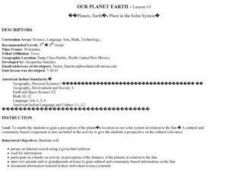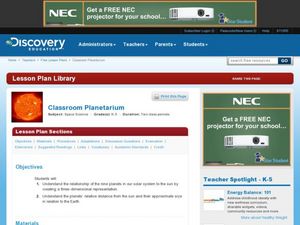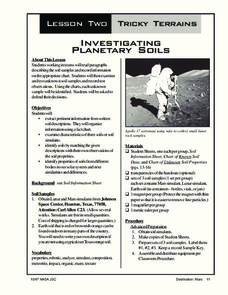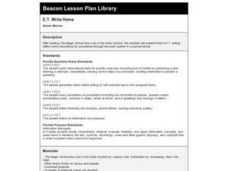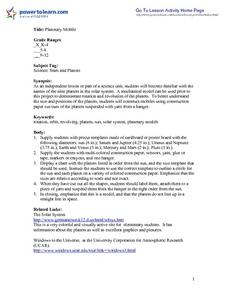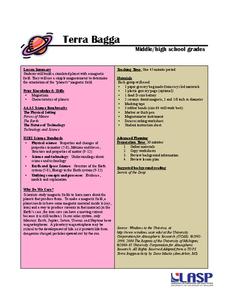Curated OER
Solar System (Lesson 2)
Eighth graders identify the objects that make up the solar system. They define new vocabulary and practice using them. They discover that the sun is a star.
Curated OER
Planet Picking
Students arrange the planets according to their distances from the sun. In this astronomy lesson plan, students list interesting properties about each planet. They identify an unknown planet photo.
Curated OER
Earth's Place in the Solar System
Learners study and discuss the planets. They create a visual representation of the layout of the solar system and color it. They also write an informative/narrative summary report on the cultural relevance of the Sun.
Curated OER
Our Solar System
In this solar system worksheet, learners find the names of the eight planets in the word search puzzle. The names of the planets are listed.
Curated OER
What are Stars?
Students research the solar system and it's characteristics. For this solar system lesson, students are broken into 4 groups, each assigned a specific part of the solar system. Students use the Internet to research their part...
Curated OER
Classroom Planetarium
Students work in groups to create the planets of the solar system. In this planets lesson plan, students create a hanging solar system taking into account the size, shape and position of the planets. Students discuss the...
Scholastic
Lesson One: The Earth, Background and Glossary
How much do you really know about our planet? Middle schoolers build up their prior knowledge about Earth, its placement in the solar system, its composition, and important geological vocabulary with an introductory earth science lesson.
Curated OER
Sky Watching
Students complete night-sky observations to understand how our knowledge of the sky has been enhanced by telescopes. Students complete a timeline worksheet giving the history of telescopes. Students then then make their own observations...
Curated OER
Making Regolith
You may not be able to take a field trip to the moon, but that doesn't mean your class can't study moon rocks. Using graham crackers as the moon's bedrock and powdered donuts as micrometeorites, young scientists simulate...
Curated OER
Earth Science
Students explore the planets and celestial bodies in our solar system. In this outer space lesson plan, students identify the planets and record journal information about them and other celestial bodies. Students define outer space words.
Curated OER
Investigating Planetary Soils
Students study soil characteristics and identify properties of soils from different parts of the solar system. For this soil lesson students divide into groups, read soil descriptions, test and record soil samples.
Curated OER
Fine Motor Skills
Fourth graders discuss what they know about the planets, space, and the solar system including the colors of the planets. They also talk about why the planets are the color that they are. Next, they color cut-outs of the planets using...
Laboratory for Atmospheric and Space Physics
Where Are We Going?
Come take a ride on the space bus! Scholars go on an imaginary trip to pick up their peers from the inner and outer planets while reinforcing math skills. First, learners round decimals to identify each planets' distance from Earth....
Laboratory for Atmospheric and Space Physics
Jupiter’s Relative Size
How do you properly illustrate the extreme size difference between two planets—Earth and Jupiter? With the help of jellybeans, of course! Create a scale model of Jupiter's mass compared to Earth using a fishbowl, 1,400 beans, and a...
Curated OER
Cometary Orbits
Students study orbits and ellipses and see the differences between orbits and comets. In this investigative lesson plan students do an activity that shows them what objects are more like comets and fill out a worksheet.
Curated OER
E.T. Write Home
Students read the book, The Magic School Bus Lost in the Solar System, and discuss the planets visited by the characters in the book. They write journal entries from the viewpoint of E.T., writing letters home describing his travels in...
Curated OER
Outpost Communications Exercise
Pupils engage in a unique study of the solar system with the integration of technology in the form of e-mail. They communicate to each other on e-mail and give clues to an imaginary location without revealing the source the students must...
Curated OER
Our Solar System
Sixth graders use the internet to examine the different bodies in space. In groups, they select one project they want to complete and are given a timeline for when the sections are due. To end the lesson, they present their information...
Curated OER
Meet the Neighbors: Planets Around Nearby Stars
Students explain why a transiting planet causes a periodic dimming in the light from its parent star. They determine the radius of a planet, and its orbital distance, by analyzing data and manipulating equations. Students compare the...
Curated OER
Planetary Poster
Pupils engage in a study about the planets and create a poster as one of the projects during the study. They create individual charts for mapping the solar system so the locations can be found in mock space missions to other planets.
Curated OER
Planetary Mobile
Young scholars receive pre-cut templates of cardboard with appropriate diameters of each planet and the sun. They use multi-colored construction paper, scissors, yarn, and other art supplies to create their own models of planets. When...
Curated OER
Planet Vacation
For this planets worksheet, students fill out a chart where they fill in the distance each planet is from the Earth, and how much travel time in years and hours it would take to get there. Students do this for 8 planets.
University of Colorado
Terra Bagga
One way to identify possible volcanic activity on other planets is by testing the planet for magnetism. A science lesson begins with pupils constructing their own planet from a dead battery, magnets, paper, and tape before labeling...
University of Colorado
Terra Bagga
Earth's magnetic poles switch positions about every 200,000—300,000 years. In the activity, groups create a planet with a magnetic field. Once made, they use a magnetometer to determine the orientation of the planet's magnetic field....
Other popular searches
- Solar System Inner Planets
- Solar System Planets
- Solar System and Planets
- Science Planets Solar System


